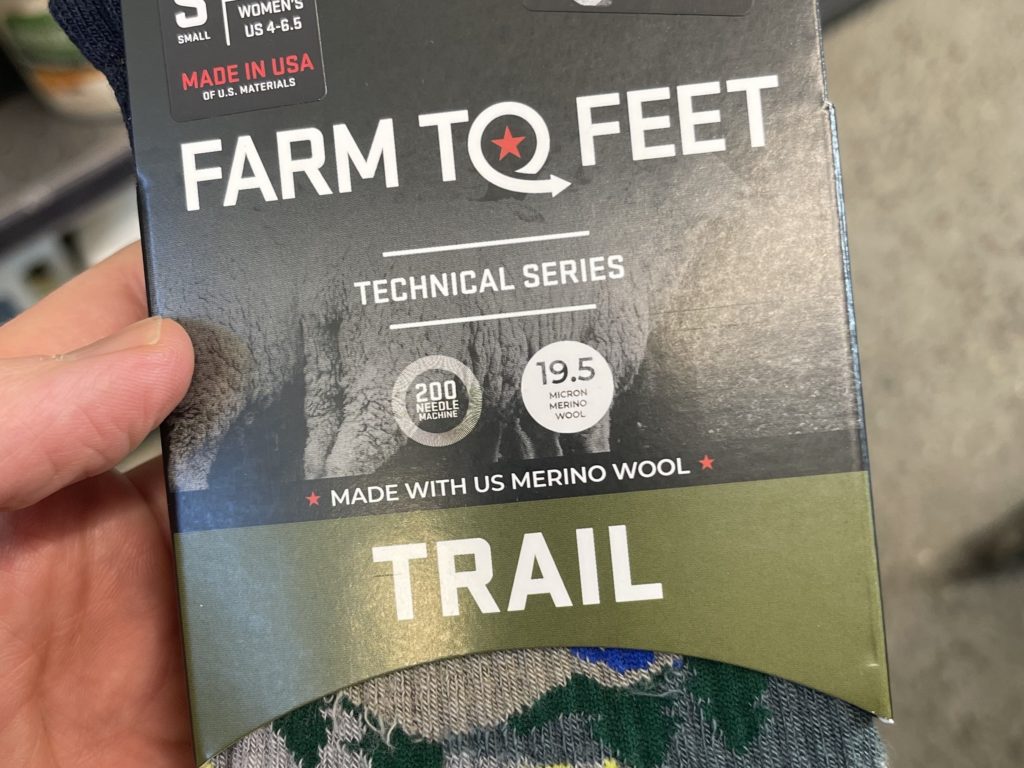I bought several pairs of Farm to Feet socks at my local Whole Foods here in Jackson, Wyoming. The brand has done an excellent job with the design of their socks and seems to have a sincere commitment to providing their workers with a safe, healthy working environment.

Table of Contents
Our Rating: 1 / 5 (See: How Leaf Score is calculated)
Product Highlights
- Size inclusive Socks are packaged in FSC Certified paper and Farm to Feet reduced packaging weight by 21% in 2018
- Products are Made in the USA by American workers, which cuts down on the carbon footprint associated with international supply chains
- Farm to Feet pays lip service to animal welfare and reducing greenhouse gas emissions in messaging
| Country of Origin: | United States |
| Materials: | 51% nylon, 45% US merino wool, 4% LYCRA® spandex |
| Certifications: | None |
Although they do incorporate large amounts of nylon and spandex, Farm to Feet makes socks that are about 50% wool, which means that the products are made with some natural materials. They’ve also made a sincere effort to make their packaging much more sustainable by reducing weight and using FSC certified paper, so they get one leaf for these efforts.
However, despite some manufacturing and sourcing decisions that are admirable, I cannot recommend Farm to Feet socks.
Why?
Farm to feet durability issues
Despite an entire page on the Farm to Feet website devoted to durability, my experience with several pairs of these socks is that they wear out with 1.5-2 months of moderate use. They are some of the least durable socks I have ever purchased.
In fact, I have been shocked by how quickly new pairs of socks from Farm to Feet quickly become threadbare and develop holes on the heel, ball of the feet, and toes. The brand mentions the Japanese tradition of “Shashiko,” which is the practice of mending and repairing old clothing, rather than buying new or throwing away. My wife, who is Japanese, would laugh at me were I to suggest repairing these socks, because they are so obviously cheap and insubstantial.
The quality of the product isn’t worthy of a repair; instead contentious consumers should avoid purchasing Farm to Feet altogether.
I was originally drawn in by the great designs, and bought these socks on an impulse buy at the store because I loved the look, but have learned fast not to make that mistake again.
Farm to Feet would be well advised to go back to the drawing board and improve their socks so they last far longer than they do.
Until then, and despite some admirable packaging decisions, we have to report honestly and label this brand as an aspiring eco-friendly manufacturer only.
Interesting. I have a pair of Farm to Feet socks and I really like them. Granted I am gentle on them and don’t wear them constantly, but I chose them because of the lighter weight which makes them perfect for pairing with dress shoes. The only thing is they don’t always have solid neutral office appropriate colors in stock. Have you tried Darn Tough?
No, I haven’t tried Darn Tough, have you had a good experience?